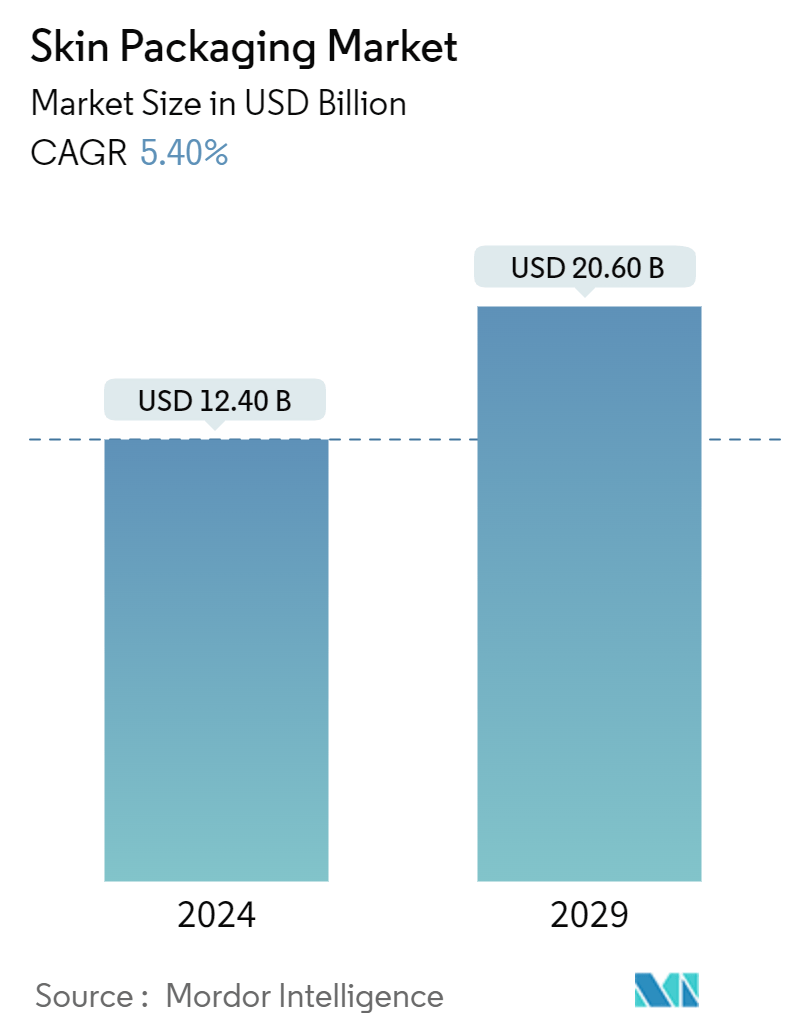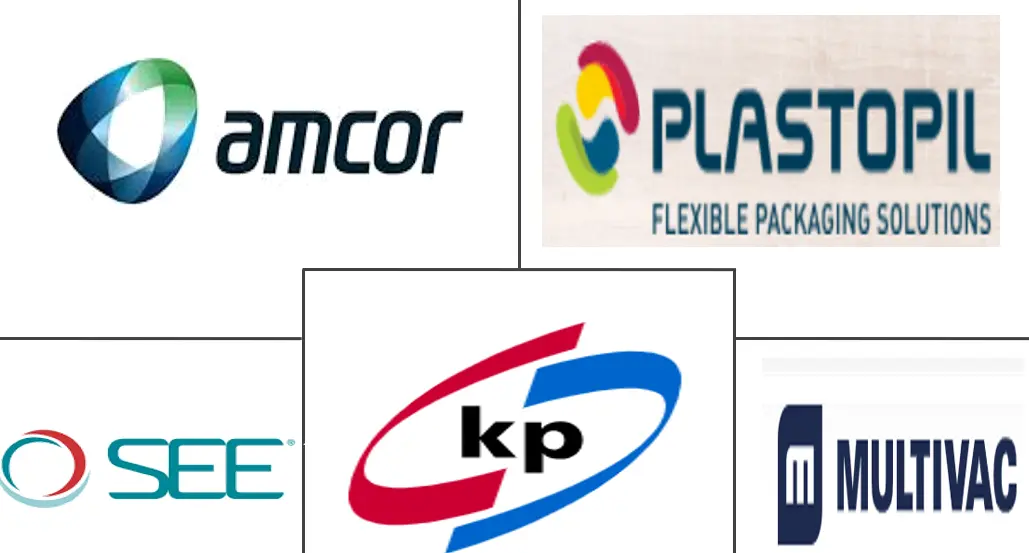Market Size of Skin Packaging Industry

| Study Period | 2019 - 2029 |
| Market Size (2024) | USD 12.40 Billion |
| Market Size (2029) | USD 20.60 Billion |
| CAGR (2024 - 2029) | 5.40 % |
| Fastest Growing Market | Asia Pacific |
| Largest Market | North America |
| Market Concentration | Low |
Major Players
*Disclaimer: Major Players sorted in no particular order |
Skin Packaging Market Analysis
The Skin Packaging Market size is estimated at USD 12.40 billion in 2024, and is expected to reach USD 20.60 billion by 2029, growing at a CAGR of 5.40% during the forecast period (2024-2029).
- Skin packaging is a state-of-the-art technique consisting of thin layers of plastic film over a thermoforming tray or manufactured plastic container. In addition to allowing customers to look at the product without any risk of contamination, this plastic film provides a very transparent layer of protection against air and moisture that may degrade products or cause them to spoil.
- The growing need to protect food, increase shelf life, reduce waste, and increase visibility is raising the demand for skin packaging from the food industry since it offers benefits, such as reliability, with durable trays, which support and protect products during shipping, storage, and display.
- The growing demand for the preservation of various meat and dairy products, such as cheese, cold cuts, and various forms of beef, is driving the skin packaging market. As vacuum skin packaging provides better durability, traditional packaging techniques have been phased out in various food industry applications in recent years. Moreover, it provides an additional layer that protects the food compared to conventional packaging solutions, increasing its adoption and supporting market growth.
- The demand for skin packaging has increased globally due to the growing understanding of the advantages of recycling and bioplastics. Key market drivers include the abundance of raw materials and the quickening pace of technical developments in the skin packaging market.
- According to the Packaging Industry Association of India (PIAI), the Indian skin packaging market will be worth more than USD 204.81 billion by the end of 2025. The market will continue to develop throughout the forecast period due to rising per capita spending and growing demand for superior products with flexible plastic packaging that is light and durable and can provide protection against contamination.
- In part, the market is driven by consumers wanting longer shelf life and better visibility of products. Skin packaging offers better product protection, preserving the integrity and freshness of the goods. It also gives the goods better visibility so that consumers can see the actual product and its characteristics, which may motivate purchases.
- Since electronic products and components are sensitive to water, they require protective armor. Hence, the demand for skin packaging is high due to its water-resistant properties. It also helps protect the body from damage and scratches in electrical products. Furthermore, industrial goods, such as tools and automotive parts, are prone to body damage and are exposed to dynamic weather conditions, increasing the need for skin packaging in different industrial goods packaging applications.
- Sustainable packaging is the future, and the quest for eco-friendly alternatives is a top priority in the food industry. Fresh meat packaging made from conventional plastic is facing pressure; hence, the industry is shifting toward eco-friendly solutions. In April 2023, Stora Enso's new Trayforma BarrPeel (barrier-coated paperboard for vacuum skin packaging) aimed to enable perishable products to be packaged in recyclable paperboard trays, reducing the overall plastic content of packaging to less than 10%.
- The fluctuating prices of raw materials and stringent regulations imposed by the government on the application of plastic for food packaging are likely to restrain market growth. The availability of environmentally friendly alternatives and rising environmental concerns are further expected to hamper market growth.
Skin Packaging Industry Segmentation
Skin packaging is carded packaging in which a product is placed on a piece of paperboard, and a thin sheet of transparent plastic is over the product and paperboard. The printed paperboard usually includes a heat-seal coating; customers can see through the plastic without contamination. Skin packaging is a product packaging method that involves applying heat to a thin plastic sheet or film. Skin packaging solutions provide total product safety, complete lockdown product protection, and complete product visibility.
The skin packaging market is segmented by application (food (meat, fish, and seafood, processed food, and cheese), industrial goods (electronic and electrical components), medical devices, and durable consumer goods) and geography (North America (the United States, Canada), Europe (Germany, France, the United Kingdom, and Rest of Europe), Asia-Pacific (China, India, Japan, Australia and New Zealand, and Rest of Asia-Pacific), Latin America (Brazil, Mexico, and Rest of Latin America), and Middle East and Africa (the United Arab Emirates, Saudi Arabia, South Africa, and Rest of Middle East and Africa). The market sizes and forecasts are provided in terms of value (USD) for all the above segments.
| By Application | ||||||
| ||||||
| Industrial Goods (Including Electronic and Electrical Components) | ||||||
| Medical Devices | ||||||
| Durable Consumer Goods |
| By Geography *** | ||||||
| ||||||
| ||||||
| ||||||
| ||||||
|
Skin Packaging Market Size Summary
The skin packaging market is experiencing significant growth, driven by advancements in packaging technology that enhance its efficiency and cost-effectiveness. This packaging method reduces the need for protective fillers, making it a more economical choice compared to traditional methods. The market's expansion is fueled by factors such as urbanization, globalization, and the increasing demand for convenient packaging solutions. Skin packaging is particularly popular in the food industry, where it is used to extend the shelf life of products like meat, seafood, and poultry while minimizing material usage. Its application in retail settings also allows for better product visibility without the need to open packages. Despite its benefits, the market faces challenges such as high initial costs, the availability of substitutes, and supply chain disruptions caused by the COVID-19 pandemic. Environmental concerns and regulatory pressures regarding plastic use further complicate market dynamics.
The Asia-Pacific region holds a significant share of the global skin packaging market, attributed to factors like a growing population, rising disposable incomes, and an expanding pharmaceutical industry. The region's robust food and plastic manufacturing sectors contribute to the market's growth potential. The competitive landscape is moderately fragmented, with numerous players investing in research and development to differentiate their products. Recent innovations and partnerships, such as those by Amcor and Sealed Air, highlight the industry's focus on sustainability and recycling. The market is also witnessing collaborations aimed at enhancing product offerings and expanding market reach. These developments underscore the industry's commitment to addressing environmental concerns while meeting the evolving demands of consumers and businesses alike.
Skin Packaging Market Size - Table of Contents
-
1. MARKET INSIGHTS
-
1.1 Market Overview
-
1.2 Industry Attractiveness - Porter's Five Forces Analysis
-
1.2.1 Bargaining Power of Suppliers
-
1.2.2 Bargaining Power of Consumers
-
1.2.3 Threat of New Entrants
-
1.2.4 Threat of Substitutes
-
1.2.5 Intensity of Competitive Rivalry
-
-
1.3 Industry Value Chain Analysis
-
-
2. MARKET SEGMENTATION
-
2.1 By Application
-
2.1.1 Food
-
2.1.1.1 Meat
-
2.1.1.2 Fish and Seafood
-
2.1.1.3 Processed Food
-
2.1.1.4 Cheese
-
-
2.1.2 Industrial Goods (Including Electronic and Electrical Components)
-
2.1.3 Medical Devices
-
2.1.4 Durable Consumer Goods
-
-
2.2 By Geography ***
-
2.2.1 North America
-
2.2.1.1 United States
-
2.2.1.2 Canada
-
-
2.2.2 Europe
-
2.2.2.1 United kingdom
-
2.2.2.2 France
-
2.2.2.3 Germany
-
-
2.2.3 Asia
-
2.2.3.1 China
-
2.2.3.2 Japan
-
2.2.3.3 India
-
2.2.3.4 Australia and New Zealand
-
-
2.2.4 Latin America
-
2.2.4.1 Brazil
-
2.2.4.2 Mexico
-
-
2.2.5 Middle East And Africa
-
2.2.5.1 Saudi Arabia
-
2.2.5.2 United Arab Emirates
-
2.2.5.3 South Africa
-
-
-
Skin Packaging Market Size FAQs
How big is the Skin Packaging Market?
The Skin Packaging Market size is expected to reach USD 12.40 billion in 2024 and grow at a CAGR of 5.40% to reach USD 20.60 billion by 2029.
What is the current Skin Packaging Market size?
In 2024, the Skin Packaging Market size is expected to reach USD 12.40 billion.

